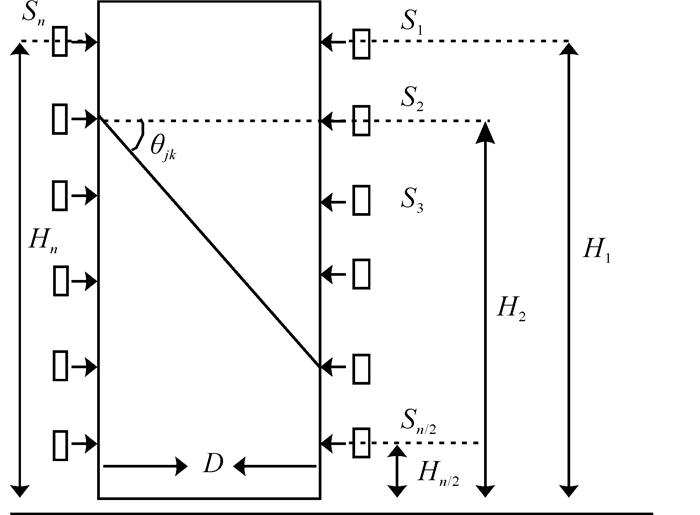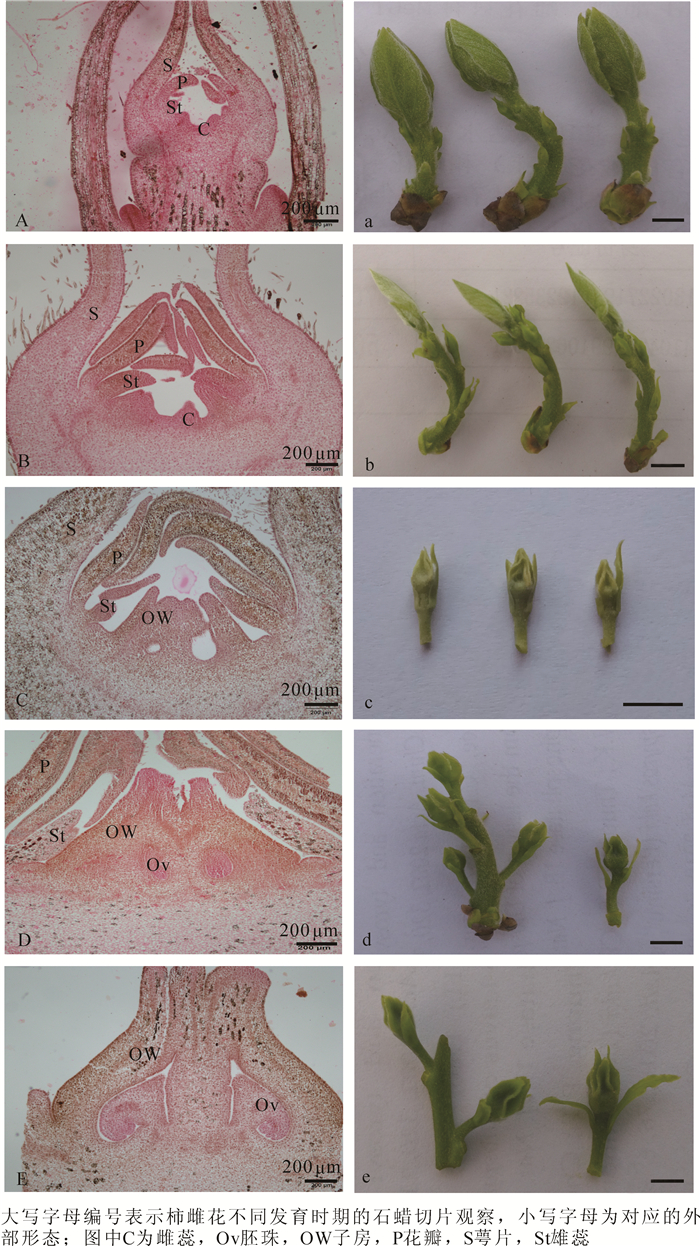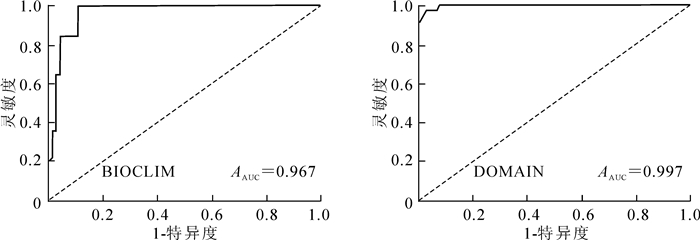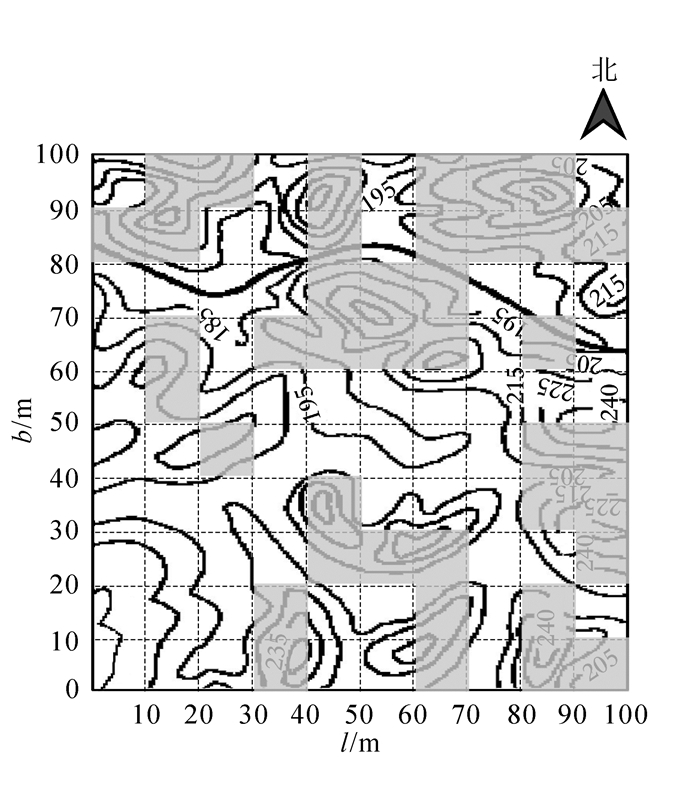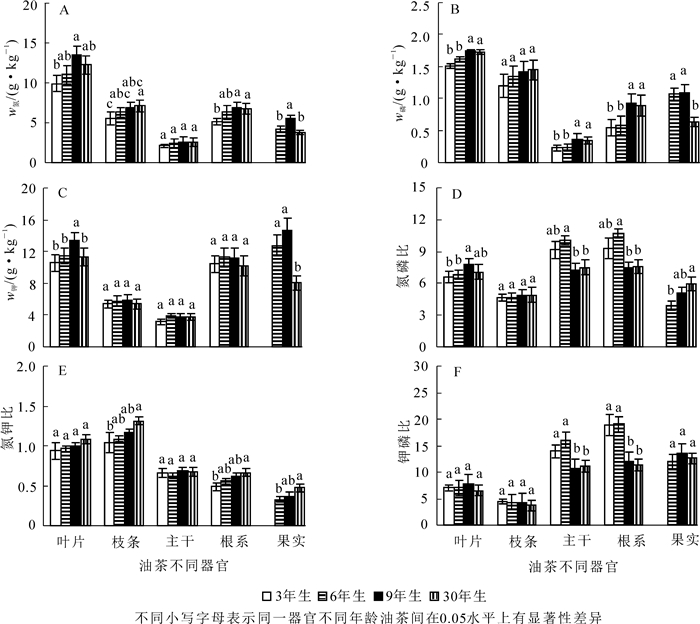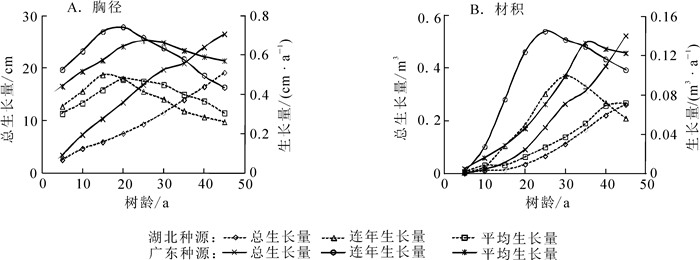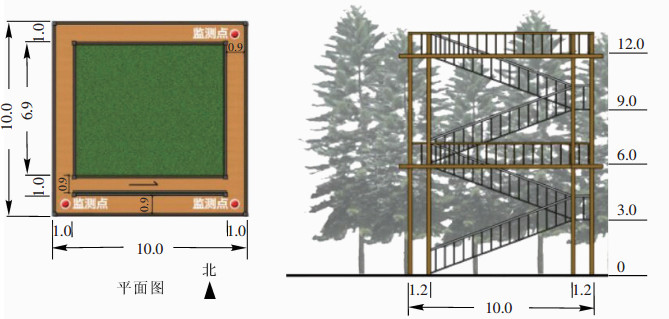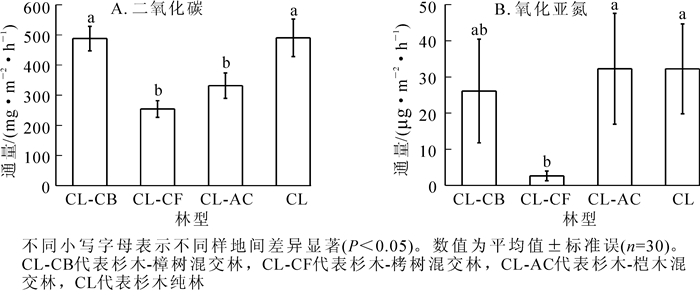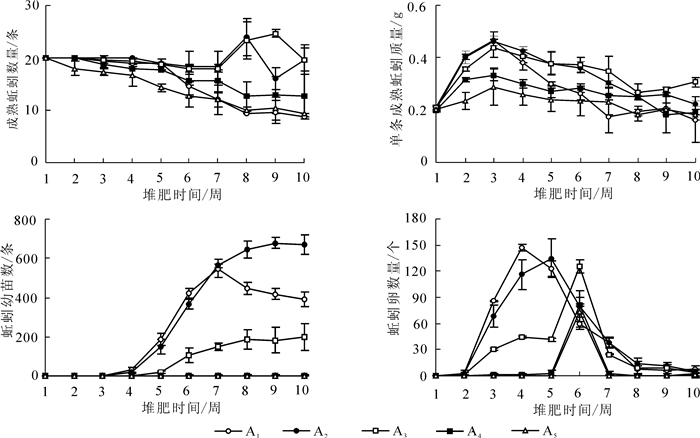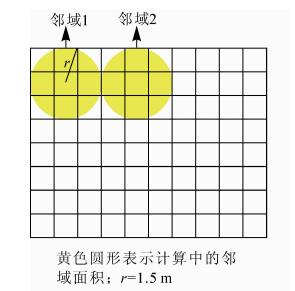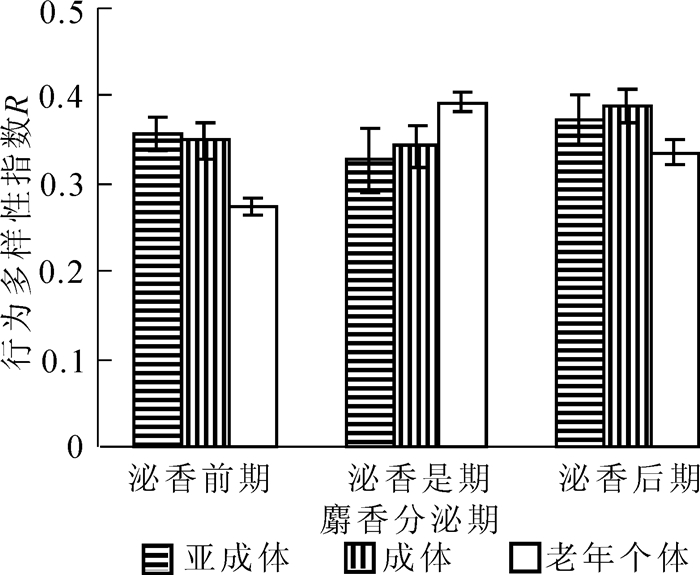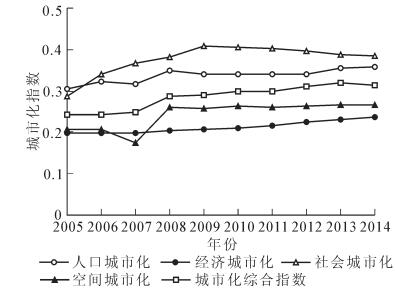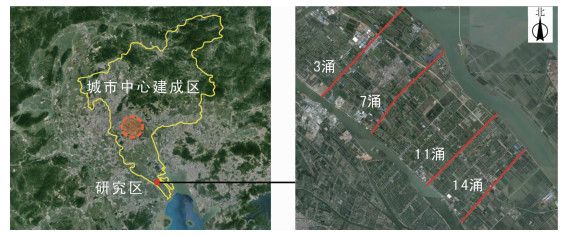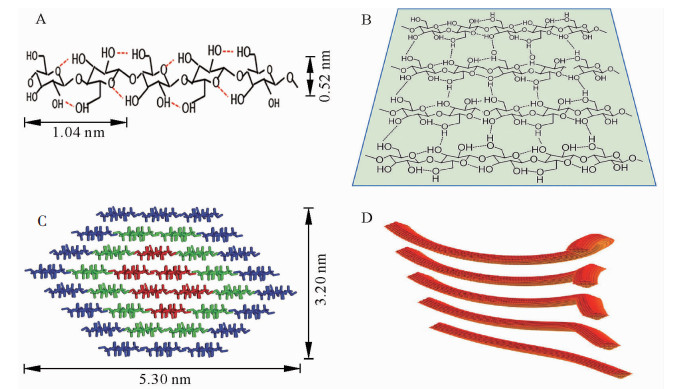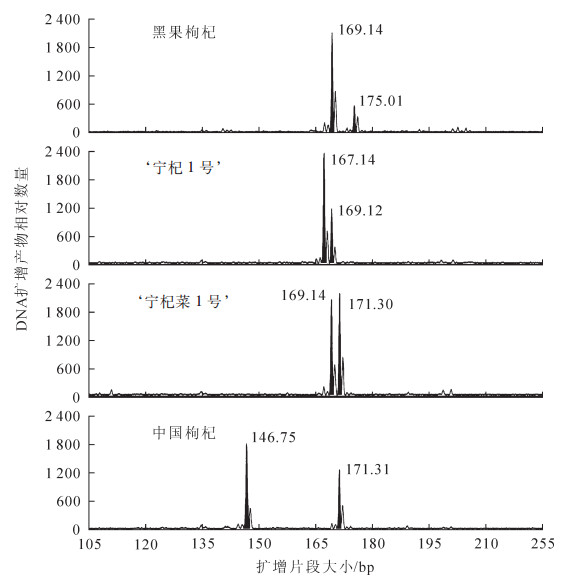2019 Vol. 36, No. 2
column
2019, 36(2): 211-218.
doi: 10.11833/j.issn.2095-0756.2019.02.001
Abstract:
To generate and obtain the shape, size, and position of defects in the radial and longitudinal (RL) planes of wood, this study presented a new method for imaging defects on the RL planes in wood. First, based on the propagation law of stress waves for the RL planes of wood, a modified method of propagating the velocity of stress waves was proposed. Then the propagation velocity of the stress wave was converted into a value at estimated points. Finally, a velocity correction interpolation method (VCI) was proposed to reconstruct any defects in different tree samples. Imaged results were then compared to the inverse distance weighted (IDW) interpolation method and quantitatively analyzed using the method of confusion matrix. Experimental results showed that (1) the proposed method could reconstruct the size of the internal wood defects and their location with imaging results of the defects being basically consistent with real defects. (2) Compared to imaged results from IDW, the proposed method has higher accuacy rate when reconstructing the size, shape, and location of the defect. (3) The quantitative analyses showed that the proposed method improved in average accuracy, average precision, and the average recall. Thus, imaged results of defects with different shapes showed the effectiveness of the proposed method in reconstruction defects in RL plans of wood.
To generate and obtain the shape, size, and position of defects in the radial and longitudinal (RL) planes of wood, this study presented a new method for imaging defects on the RL planes in wood. First, based on the propagation law of stress waves for the RL planes of wood, a modified method of propagating the velocity of stress waves was proposed. Then the propagation velocity of the stress wave was converted into a value at estimated points. Finally, a velocity correction interpolation method (VCI) was proposed to reconstruct any defects in different tree samples. Imaged results were then compared to the inverse distance weighted (IDW) interpolation method and quantitatively analyzed using the method of confusion matrix. Experimental results showed that (1) the proposed method could reconstruct the size of the internal wood defects and their location with imaging results of the defects being basically consistent with real defects. (2) Compared to imaged results from IDW, the proposed method has higher accuacy rate when reconstructing the size, shape, and location of the defect. (3) The quantitative analyses showed that the proposed method improved in average accuracy, average precision, and the average recall. Thus, imaged results of defects with different shapes showed the effectiveness of the proposed method in reconstruction defects in RL plans of wood.
2019, 36(2): 219-226.
doi: 10.11833/j.issn.2095-0756.2019.02.002
Abstract:
To make better use of logging residues of Phyllostachys edulis, this study used bamboo culm tops and branches as research objects. Properties of the bamboo culm tops and branches, such as chemical composition and fiber morphology, were analyzed by Stereoscopic Microscope, Fourier Transform Infrared Spectrometer (FTIR), and Thermogravimetric Analyzer (four-year-old bamboo). The kraft process was used for pulp and paper and evaluating its pulping properties. The results showed that the logging residues of moso bamboo were mainly composed of cellulose, hemicellulose and lignin. The contents of nitric acid-ethanol cellulose in bamboo residues were between 342.9-409.3 g·kg-1, and the contents of α-cellulose were about 420.0 g·kg-1. The insoluble lignin contents were about 240.0 g·kg-1, the phenyl alcohol extract contents were 36.7-54.3 g·kg-1, the 10.0 g·L-1 NaOH extract contents were 256.7-296.7 g·kg-1, the ash contents were 8.5-26.5 g·kg-1, and the hemicellulose bamboo logging residues were mainly composed of sugar units such as arabinose, xylose and furfural. The contents of xylose were more than 85.0%. The bamboo fibers of logging residues were mainly distributed in the range of 400-2 000 μm and the aspect ratio was 64.70-65.54; The pyrolysis process of bamboo logging residues is mainly divided into three stages, and the thermal decomposition process mainly occurs in the second stage. The maximum thermal decomposition temperature of the bamboo logging residue was 339-341℃; the bamboo logging residues were treated by the sulfate method. After pulping, the pulp yield was 44.71%, with good pulping performance, high tensile strength (63.88 N·m-1·g-1) and burst strength (4.14 kPa·m-2·g-1), better than Dendrocalamus sinicus and D. peculiaris, and the logging residues from bamboo could be used as pulp instead of wood.
To make better use of logging residues of Phyllostachys edulis, this study used bamboo culm tops and branches as research objects. Properties of the bamboo culm tops and branches, such as chemical composition and fiber morphology, were analyzed by Stereoscopic Microscope, Fourier Transform Infrared Spectrometer (FTIR), and Thermogravimetric Analyzer (four-year-old bamboo). The kraft process was used for pulp and paper and evaluating its pulping properties. The results showed that the logging residues of moso bamboo were mainly composed of cellulose, hemicellulose and lignin. The contents of nitric acid-ethanol cellulose in bamboo residues were between 342.9-409.3 g·kg-1, and the contents of α-cellulose were about 420.0 g·kg-1. The insoluble lignin contents were about 240.0 g·kg-1, the phenyl alcohol extract contents were 36.7-54.3 g·kg-1, the 10.0 g·L-1 NaOH extract contents were 256.7-296.7 g·kg-1, the ash contents were 8.5-26.5 g·kg-1, and the hemicellulose bamboo logging residues were mainly composed of sugar units such as arabinose, xylose and furfural. The contents of xylose were more than 85.0%. The bamboo fibers of logging residues were mainly distributed in the range of 400-2 000 μm and the aspect ratio was 64.70-65.54; The pyrolysis process of bamboo logging residues is mainly divided into three stages, and the thermal decomposition process mainly occurs in the second stage. The maximum thermal decomposition temperature of the bamboo logging residue was 339-341℃; the bamboo logging residues were treated by the sulfate method. After pulping, the pulp yield was 44.71%, with good pulping performance, high tensile strength (63.88 N·m-1·g-1) and burst strength (4.14 kPa·m-2·g-1), better than Dendrocalamus sinicus and D. peculiaris, and the logging residues from bamboo could be used as pulp instead of wood.
2019, 36(2): 227-235.
doi: 10.11833/j.issn.2095-0756.2019.02.003
Abstract:
A whole genome re-sequencing analysis was carried out with plantlets for two cultivars ('Liuyuexue' and 'Huangpixiao') of early pear (Pyrus pyrifolia) in Shangrao using a common variant analysis for nsSNPs (nonsynonymous mutations single-nucleotide polymorphism). Results showed a total number of single-nucleotide polymorphisms (SNP) in the two samples of 6 171 357 for 'Liuyuexue' and 6 140 603 for 'Huangpixiao', and a total number of nsSNP within the coding region of 335 659 for 'Liuyuexue' and 332 280 for 'Huangpixiao'. Using the common variant analysis for nsSNPs, 2 282 nsSNPs were found associated with 2 067 genes. The total indel numbers of the two samples were 800 388 for 'Liuyuexue' and 799 603 for 'Huangpixiao'. In the coding area, 15 509 indels for 'Liuyuexue' and 15 274 indels for 'Huangpixiao' were obtained, and 5 115 differential indels were associated with 3 682 genes. Key genes of the tobacco mosaic virus resistant protein N and the disease resistant protein as well as others were mutated. Enriched gene ontology (GO) terms of differential nsSNPs and differential indels were consistent. Results of this study could provide important references for the development of SNP and indel related markers and the extraction of excellent genes for the two cultivars ('Liuyuexue' and 'Huangpixiao') of early pear in Shangrao.
A whole genome re-sequencing analysis was carried out with plantlets for two cultivars ('Liuyuexue' and 'Huangpixiao') of early pear (Pyrus pyrifolia) in Shangrao using a common variant analysis for nsSNPs (nonsynonymous mutations single-nucleotide polymorphism). Results showed a total number of single-nucleotide polymorphisms (SNP) in the two samples of 6 171 357 for 'Liuyuexue' and 6 140 603 for 'Huangpixiao', and a total number of nsSNP within the coding region of 335 659 for 'Liuyuexue' and 332 280 for 'Huangpixiao'. Using the common variant analysis for nsSNPs, 2 282 nsSNPs were found associated with 2 067 genes. The total indel numbers of the two samples were 800 388 for 'Liuyuexue' and 799 603 for 'Huangpixiao'. In the coding area, 15 509 indels for 'Liuyuexue' and 15 274 indels for 'Huangpixiao' were obtained, and 5 115 differential indels were associated with 3 682 genes. Key genes of the tobacco mosaic virus resistant protein N and the disease resistant protein as well as others were mutated. Enriched gene ontology (GO) terms of differential nsSNPs and differential indels were consistent. Results of this study could provide important references for the development of SNP and indel related markers and the extraction of excellent genes for the two cultivars ('Liuyuexue' and 'Huangpixiao') of early pear in Shangrao.
2019, 36(2): 236-246.
doi: 10.11833/j.issn.2095-0756.2019.02.004
Abstract:
The abortion of sex organs in Diospyros kaki (persimmon) has not yet been clearly elucidated. To investigate the key period for expression patterns dealing with abortion of sex organs and related-genes in persimmon, paraffin section method and morphology changes, as well as a qRT-PCR analysis of six floral sex differentiation-related genes, were conducted with a 10-year-old monoecious persimmon cultivar 'Zenjimaru' in the Yuanyang Practice Base belonging to the Non-timber Forestry Research & Development Center, Chinese Academy of Forestry. Results showed that stamen primordium in female flowers and pistil primordium in male flowers both aborted in mid-April with the female branch 5.0-6.0 cm in length, the male branch 6.0-8.0 cm in length, the female floral bud 1.0 cm in length, and the male floral bud 1.0-2.0 cm in length. In addition, during differentiation, excluding the April 5th and April 8th stages, ANT and LYK3 genes were significantly higher (P < 0.05) in female floral buds than male; whereas, AP2 and ABCC10 genes in male floral buds were significantly higher than female (P < 0.05). The BI-1 level in female floral buds was 1.5 to 2.0 times greater than those in male buds in April 5th and April 14th (the key period for abortion of sex organs), respectively, but it was 97.5%, 89.2%, and 83.9% in the other stages. Thus, the BI-1 gene may act as an apoptosis-inhibiter and may be indirectly related to development of stamen primordia. Exogenous phytohormones, that regulate the sex of flower buds and cultivate male persimmon germplasm resources, should be considered along with conventional management before abortion of corresponding sexual organs in mid-April.
The abortion of sex organs in Diospyros kaki (persimmon) has not yet been clearly elucidated. To investigate the key period for expression patterns dealing with abortion of sex organs and related-genes in persimmon, paraffin section method and morphology changes, as well as a qRT-PCR analysis of six floral sex differentiation-related genes, were conducted with a 10-year-old monoecious persimmon cultivar 'Zenjimaru' in the Yuanyang Practice Base belonging to the Non-timber Forestry Research & Development Center, Chinese Academy of Forestry. Results showed that stamen primordium in female flowers and pistil primordium in male flowers both aborted in mid-April with the female branch 5.0-6.0 cm in length, the male branch 6.0-8.0 cm in length, the female floral bud 1.0 cm in length, and the male floral bud 1.0-2.0 cm in length. In addition, during differentiation, excluding the April 5th and April 8th stages, ANT and LYK3 genes were significantly higher (P < 0.05) in female floral buds than male; whereas, AP2 and ABCC10 genes in male floral buds were significantly higher than female (P < 0.05). The BI-1 level in female floral buds was 1.5 to 2.0 times greater than those in male buds in April 5th and April 14th (the key period for abortion of sex organs), respectively, but it was 97.5%, 89.2%, and 83.9% in the other stages. Thus, the BI-1 gene may act as an apoptosis-inhibiter and may be indirectly related to development of stamen primordia. Exogenous phytohormones, that regulate the sex of flower buds and cultivate male persimmon germplasm resources, should be considered along with conventional management before abortion of corresponding sexual organs in mid-April.
2019, 36(2): 247-254.
doi: 10.11833/j.issn.2095-0756.2019.02.005
Abstract:
To find the geographical distribution pattern of the National Level Ⅱ wild protected plant Platycrater arguta and to understand its geographical migration patterns with climate change, DIVA-GIS software and its integrated BIOCLIM and DOMAIN models were used in combination with 80 precision distribution points. Distribution point information was used to forecast the potential distribution area and analysis included the Receiver Operating Characteristic (ROC) curve test for the main climatic factors affecting distribution and a principal component analysis. The precise distribution information of P. arguta was imported into DIVA-GIS software, and the potential distribution area of P. arguta was predicted through the modelling panel. Prediction results from the two models both indicated that current potential distribution areas of P. arguta were concentrated at the junction of Zhejiang, Jiangxi, and Fujian Provinces in China as well as Shikoku Island in Japan. The optimum living area for P. arguta was greatly reduced with future climate estimates, and the low-grade habitat area shifted overall to the west and to higher altitudes. The ROC curve test showed that the area under the curve (AUC) values of both models reached more than 0.9 indicating that model prediction results were credible. The principal component analysis of 19 climatic variables showed that annual precipitation (BIO12), the most humid seasonal precipitation (BIO16), and the warmest seasonal precipitation (BIO18) were the major climatic factors that affected distribution of Platycrater arguta indicating that water was the main factor. Thus, research and protection strategies should be carried out based on predicted distribution areas.
To find the geographical distribution pattern of the National Level Ⅱ wild protected plant Platycrater arguta and to understand its geographical migration patterns with climate change, DIVA-GIS software and its integrated BIOCLIM and DOMAIN models were used in combination with 80 precision distribution points. Distribution point information was used to forecast the potential distribution area and analysis included the Receiver Operating Characteristic (ROC) curve test for the main climatic factors affecting distribution and a principal component analysis. The precise distribution information of P. arguta was imported into DIVA-GIS software, and the potential distribution area of P. arguta was predicted through the modelling panel. Prediction results from the two models both indicated that current potential distribution areas of P. arguta were concentrated at the junction of Zhejiang, Jiangxi, and Fujian Provinces in China as well as Shikoku Island in Japan. The optimum living area for P. arguta was greatly reduced with future climate estimates, and the low-grade habitat area shifted overall to the west and to higher altitudes. The ROC curve test showed that the area under the curve (AUC) values of both models reached more than 0.9 indicating that model prediction results were credible. The principal component analysis of 19 climatic variables showed that annual precipitation (BIO12), the most humid seasonal precipitation (BIO16), and the warmest seasonal precipitation (BIO18) were the major climatic factors that affected distribution of Platycrater arguta indicating that water was the main factor. Thus, research and protection strategies should be carried out based on predicted distribution areas.
2019, 36(2): 255-263.
doi: 10.11833/j.issn.2095-0756.2019.02.006
Abstract:
To understand the population distribution of the National Grade Ⅱ protected plant, Magnolia zenii, and reasons for its endangered status; to reveal the ecological relationship between the M. zenii community and the environment; and to provide a theoretical basis and new methods for protecting and managing the wild germplasm resources of M. zenii, a self-organizing feature map (SOM) network was used to sort and classify the living communities of M. zenii. 40 samples (quadrats) of 10 m×10 m for forest, 5 m×5 m for shrub land and 1 m×1 m for grass land were set up and species data was recorded in each sample. The classification and ordination was carried out by use of the NNTool box in MATLAB(6.1). Results of the community structure analysis showed that (1) natural regeneration of M. zenii was lacking with the dominant species, Phoebe sheareri and Acer henryi, occupying the main living space and resources. (2) The SOM clustered 40 quadrats of plant communities to obtain seven community types. Species composition of the different community types varied, the boundaries were clear, and the ranking results were consistent with actual distribution of the dominant species. (3) Visual analysis of the environmental factors showed that M. zenii was distributed on the semi-sunny and gentle slopes. Population distribution was mainly affected by two environmental factors:slope and slope direction. (4) The SOM had a highly nonlinear fitting, could sort and classify at the same time, and could visualize the classification results to show similarity between quadrats. The study suggests that the dominant species occupy the main environmental resources of the community, which affects the growth of M. zenii population, furthermore, the special requirements of its growth process and being unable to adapt caused its endangered status. Additionally, SOM is an effective quantitative technique in plant ecology, and it is applicable to reflect the ecological relationship of population, community, and the environment.
To understand the population distribution of the National Grade Ⅱ protected plant, Magnolia zenii, and reasons for its endangered status; to reveal the ecological relationship between the M. zenii community and the environment; and to provide a theoretical basis and new methods for protecting and managing the wild germplasm resources of M. zenii, a self-organizing feature map (SOM) network was used to sort and classify the living communities of M. zenii. 40 samples (quadrats) of 10 m×10 m for forest, 5 m×5 m for shrub land and 1 m×1 m for grass land were set up and species data was recorded in each sample. The classification and ordination was carried out by use of the NNTool box in MATLAB(6.1). Results of the community structure analysis showed that (1) natural regeneration of M. zenii was lacking with the dominant species, Phoebe sheareri and Acer henryi, occupying the main living space and resources. (2) The SOM clustered 40 quadrats of plant communities to obtain seven community types. Species composition of the different community types varied, the boundaries were clear, and the ranking results were consistent with actual distribution of the dominant species. (3) Visual analysis of the environmental factors showed that M. zenii was distributed on the semi-sunny and gentle slopes. Population distribution was mainly affected by two environmental factors:slope and slope direction. (4) The SOM had a highly nonlinear fitting, could sort and classify at the same time, and could visualize the classification results to show similarity between quadrats. The study suggests that the dominant species occupy the main environmental resources of the community, which affects the growth of M. zenii population, furthermore, the special requirements of its growth process and being unable to adapt caused its endangered status. Additionally, SOM is an effective quantitative technique in plant ecology, and it is applicable to reflect the ecological relationship of population, community, and the environment.
2019, 36(2): 264-270.
doi: 10.11833/j.issn.2095-0756.2019.02.007
Abstract:
To better understand the distribution of nitrogen (N), phosphorus (P), and potassium (K) over time in different organs of Camellia oleifera, a special edible oil tree species in China, samples of leaves, branches, stems, roots and fruits at different ages were collected from C. oleifera in Changshan County, Zhejiang Province. N, P and K content were measured to analyze the stoichiometry characteristics at different ages in the context of a distribution strategy. Results showed that average N content was leaf > branch > root > fruit > stem, average P content was leaf > branch > fruit > root > stem, and average K content was fruit > leaf > root > branch > stem. With an increase in age, in the branch the N and P content increased gradually; whereas, in the other organs, N and P content first increased and then decreased. For all organs, K content first increased and then decreased as time increased. The values for N:P were 3.91-10.68; for N:K were 0.33-1.31; and for K:P were 3.71-19.08. With increased age in fruits, N:P increased gradually, and in other organs N:P first increased and then decreased; in leaves, branches, roots, and fruits, N:K increased gradually; in leaves, stems, and fruits, K:P first increased and then decreased; and in branches and roots, K:P decreased gradually. In the leaves the average distribution ratio of N was 31.4%, and P was 28.6%. K had its highest proportion in the roots with an average ratio of 30.5%. Thus, the limiting element affecting the growth of C. oleifera was N; so in the process of production, N fertilizer should be properly added.
To better understand the distribution of nitrogen (N), phosphorus (P), and potassium (K) over time in different organs of Camellia oleifera, a special edible oil tree species in China, samples of leaves, branches, stems, roots and fruits at different ages were collected from C. oleifera in Changshan County, Zhejiang Province. N, P and K content were measured to analyze the stoichiometry characteristics at different ages in the context of a distribution strategy. Results showed that average N content was leaf > branch > root > fruit > stem, average P content was leaf > branch > fruit > root > stem, and average K content was fruit > leaf > root > branch > stem. With an increase in age, in the branch the N and P content increased gradually; whereas, in the other organs, N and P content first increased and then decreased. For all organs, K content first increased and then decreased as time increased. The values for N:P were 3.91-10.68; for N:K were 0.33-1.31; and for K:P were 3.71-19.08. With increased age in fruits, N:P increased gradually, and in other organs N:P first increased and then decreased; in leaves, branches, roots, and fruits, N:K increased gradually; in leaves, stems, and fruits, K:P first increased and then decreased; and in branches and roots, K:P decreased gradually. In the leaves the average distribution ratio of N was 31.4%, and P was 28.6%. K had its highest proportion in the roots with an average ratio of 30.5%. Thus, the limiting element affecting the growth of C. oleifera was N; so in the process of production, N fertilizer should be properly added.
2019, 36(2): 271-278.
doi: 10.11833/j.issn.2095-0756.2019.02.008
Abstract:
To analyze biomass allocation in the process of productivity formation in man-made forests of fast- and slow-growing provenances, Masson pine (Pinus massoniana), an important man-made forest species in south China, was used. Different mechanisms of long-term adaptation in the two provenance types were also discussed. The allocation patterns of above- and below-ground biomass in Guangdong and Hubei provenances were analyzed by using the whole plant harvest method. According to differing diameter at breast heights (DBH), the analytic trees were grouped into three classes:12 cm ≤ DBH < 18 cm, 18 cm ≤ DBH < 26 cm, and 26 cm ≤ DBH < 34 cm. Results showed that (1) The maximum of annual growth of Guangdong provenance reached 0.015 m3·a-1 in 25 years and the average annual growth of Guangdong provenance reached 0.011 m3·a-1 in 30 years. In addition, the maximum of annual growth of Hubei provenance reached 0.011 and 0.007 m3·a-1 in 30 and 42 years, respectively. (2) A large proportion of biomass was distributed to the underground part in Guangdong provenance. There were significant differences in the crude root biomass of the two provenances (P < 0.05). With the increasing of chest diameter, the relative difference were 36.5%, 62.9% and 47.5%, respectively, while there was no significant difference in the biomass between the fine roots. In the DBH range from 26 to 34 cm, there were significant differences among the biomass of the whole plant, the aboveground part, the tree trunk and the conifer (P < 0.05). (3) The biomass allocation proportion of Hubei provenance for the whole growth process in the 3 DBH classes was lower than that of the Guangdong provenance. At the initial stage of growth, the total biomass of the trunk in the Hubei provenance was higher than that in the Guangdong seed source; whereas, the biomass allocation proportions of branches and leaves was lower. As tree age increased, the proportion of total biomass for the tree trunk in the Guangdong provenance was gradually higher than that in the Hubei provenance and tended to be stable. However, the results were opposite in the branches and leaves. Therefore, the growth characters and the biomass of tree trunks showed the characteristic of rapid growth in Guangdong provenance, while quantitative maturity age was earlier than that in Hubei provenance.
To analyze biomass allocation in the process of productivity formation in man-made forests of fast- and slow-growing provenances, Masson pine (Pinus massoniana), an important man-made forest species in south China, was used. Different mechanisms of long-term adaptation in the two provenance types were also discussed. The allocation patterns of above- and below-ground biomass in Guangdong and Hubei provenances were analyzed by using the whole plant harvest method. According to differing diameter at breast heights (DBH), the analytic trees were grouped into three classes:12 cm ≤ DBH < 18 cm, 18 cm ≤ DBH < 26 cm, and 26 cm ≤ DBH < 34 cm. Results showed that (1) The maximum of annual growth of Guangdong provenance reached 0.015 m3·a-1 in 25 years and the average annual growth of Guangdong provenance reached 0.011 m3·a-1 in 30 years. In addition, the maximum of annual growth of Hubei provenance reached 0.011 and 0.007 m3·a-1 in 30 and 42 years, respectively. (2) A large proportion of biomass was distributed to the underground part in Guangdong provenance. There were significant differences in the crude root biomass of the two provenances (P < 0.05). With the increasing of chest diameter, the relative difference were 36.5%, 62.9% and 47.5%, respectively, while there was no significant difference in the biomass between the fine roots. In the DBH range from 26 to 34 cm, there were significant differences among the biomass of the whole plant, the aboveground part, the tree trunk and the conifer (P < 0.05). (3) The biomass allocation proportion of Hubei provenance for the whole growth process in the 3 DBH classes was lower than that of the Guangdong provenance. At the initial stage of growth, the total biomass of the trunk in the Hubei provenance was higher than that in the Guangdong seed source; whereas, the biomass allocation proportions of branches and leaves was lower. As tree age increased, the proportion of total biomass for the tree trunk in the Guangdong provenance was gradually higher than that in the Hubei provenance and tended to be stable. However, the results were opposite in the branches and leaves. Therefore, the growth characters and the biomass of tree trunks showed the characteristic of rapid growth in Guangdong provenance, while quantitative maturity age was earlier than that in Hubei provenance.
2019, 36(2): 279-288.
doi: 10.11833/j.issn.2095-0756.2019.02.009
Abstract:
Due to the enhancement of disturbance, the natural communities of Phoebe sheareri, a precious species peculiar to China and one of the original species for the commercial timber production of "Nanmu with golden tint", being scattered in some provinces and regions to the south of the Yangtze River, were studied. All 20 typical natural communities of P. sheareri in sample plots within 10 400 m2 of its distribution area were analyzed for responses of species diversity to different disturbance intensities and climatic conditions. Analyses of species composition, flora, and species diversity were based on the Patrick index for abundance, Shannon-Wiener index for diversity, Simpson index, and Pielou index for evenness. Results showed a total of 363 vascular species belonging to 236 genera of 103 families. Both genera and families of seed plants were abundant, but were mainly from north temperate and pan-tropical areas. Differences in the Patrick, Shannon-Wiener, Simpson, and Pielou indexes showed that both disturbance intensity and climatic conditions co-acted on the species diversity of P. sheareri-containing communities. With a disturbance of Grade Ⅴ, P. sheareri was absolutely dominant in the tree layer of the Lühetang Community, but was in a sub-dominant position in the shrub layer with a low diversity on the whole, which meant it was unfavorable for sustainable development. Disturbance intensity was found to be significantly correlated with the Patrick index (P=0.006, r=-0.643) and Shannon-Wiener index (P=0.037, r=-0.045)with a stronger disturbance having a lower species abundance and diversity in the tree layer. Also, the highest values of the Shannon-Wiener index, Simpson index, and Pielou index in the shrub layer occurred when there was a disturbance of Grade Ⅱ, meaning that an intermediate disturbance promoted species diversity in the shrub layer. Overall, P. sheareri was suitable for coexistence with many other plant species to form a community, and the disturbance intensity had more influence on species diversity in the P. sheareri community than climatic conditions.
Due to the enhancement of disturbance, the natural communities of Phoebe sheareri, a precious species peculiar to China and one of the original species for the commercial timber production of "Nanmu with golden tint", being scattered in some provinces and regions to the south of the Yangtze River, were studied. All 20 typical natural communities of P. sheareri in sample plots within 10 400 m2 of its distribution area were analyzed for responses of species diversity to different disturbance intensities and climatic conditions. Analyses of species composition, flora, and species diversity were based on the Patrick index for abundance, Shannon-Wiener index for diversity, Simpson index, and Pielou index for evenness. Results showed a total of 363 vascular species belonging to 236 genera of 103 families. Both genera and families of seed plants were abundant, but were mainly from north temperate and pan-tropical areas. Differences in the Patrick, Shannon-Wiener, Simpson, and Pielou indexes showed that both disturbance intensity and climatic conditions co-acted on the species diversity of P. sheareri-containing communities. With a disturbance of Grade Ⅴ, P. sheareri was absolutely dominant in the tree layer of the Lühetang Community, but was in a sub-dominant position in the shrub layer with a low diversity on the whole, which meant it was unfavorable for sustainable development. Disturbance intensity was found to be significantly correlated with the Patrick index (P=0.006, r=-0.643) and Shannon-Wiener index (P=0.037, r=-0.045)with a stronger disturbance having a lower species abundance and diversity in the tree layer. Also, the highest values of the Shannon-Wiener index, Simpson index, and Pielou index in the shrub layer occurred when there was a disturbance of Grade Ⅱ, meaning that an intermediate disturbance promoted species diversity in the shrub layer. Overall, P. sheareri was suitable for coexistence with many other plant species to form a community, and the disturbance intensity had more influence on species diversity in the P. sheareri community than climatic conditions.
2019, 36(2): 289-297.
doi: 10.11833/j.issn.2095-0756.2019.02.010
Abstract:
This study was conducted to explore utilization capabilities for each group of resources in grassland ecosystems at different stages of degeneration in the alpine fragile ecological zone and to provide data support for management and restoration of degraded grasslands. A grassland community survey was combined with a species importance value, Shannon-Wiener niche breadth index, and Pianka niche overlap index to analyze the characteristics of plant communities and main niche species with lightly degraded (LD), moderately degraded (MD), severely degraded (SD), and extremely severe degradation (ESD) in grasslands of the Zoigê Plateau. Results showed that (1) in LD and MD communities, the constructive species was Kobresia capillifolia, which had invaded the incombustible weeds and had a higher importance value. In SD and ESD communities, the constructive species were poaceae plants, namely Elymus nutans and Leymus secalinus, with the importance value of incombustible weeds being higher than those in the LD and MD communities. (2) As deterioration intensified, except for the higher niche breadth of constructive species, the indicator species of degraded grasslands were more niche breadth in the community increasing the growth pressure on the excellent forage species. (3) The mean value of the overlap index for all niches of the main species in the community decreased with the degree of degeneration in the order of LD(0.59), MD(0.58), SD(0.42), ESD(0.40). Also, utilization of resources between major populations tended to be more and more dispersed as the degree of degeneration increased. Higher niche overlap with other populations in the community was found that Kobresia capillifolia and Ligularia virgaurea in LD communities, K. capillifolia and Anaphalis latialata in MD communities, E. nutans in SD communities, and L. secalinus in ESD. In summary, the process of degradation of grasslands on the Zoigê Plateau was accompanied by substitution of plant populations with different resource utilization strategies.
This study was conducted to explore utilization capabilities for each group of resources in grassland ecosystems at different stages of degeneration in the alpine fragile ecological zone and to provide data support for management and restoration of degraded grasslands. A grassland community survey was combined with a species importance value, Shannon-Wiener niche breadth index, and Pianka niche overlap index to analyze the characteristics of plant communities and main niche species with lightly degraded (LD), moderately degraded (MD), severely degraded (SD), and extremely severe degradation (ESD) in grasslands of the Zoigê Plateau. Results showed that (1) in LD and MD communities, the constructive species was Kobresia capillifolia, which had invaded the incombustible weeds and had a higher importance value. In SD and ESD communities, the constructive species were poaceae plants, namely Elymus nutans and Leymus secalinus, with the importance value of incombustible weeds being higher than those in the LD and MD communities. (2) As deterioration intensified, except for the higher niche breadth of constructive species, the indicator species of degraded grasslands were more niche breadth in the community increasing the growth pressure on the excellent forage species. (3) The mean value of the overlap index for all niches of the main species in the community decreased with the degree of degeneration in the order of LD(0.59), MD(0.58), SD(0.42), ESD(0.40). Also, utilization of resources between major populations tended to be more and more dispersed as the degree of degeneration increased. Higher niche overlap with other populations in the community was found that Kobresia capillifolia and Ligularia virgaurea in LD communities, K. capillifolia and Anaphalis latialata in MD communities, E. nutans in SD communities, and L. secalinus in ESD. In summary, the process of degradation of grasslands on the Zoigê Plateau was accompanied by substitution of plant populations with different resource utilization strategies.
2019, 36(2): 298-306.
doi: 10.11833/j.issn.2095-0756.2019.02.011
Abstract:
Research on ozone concentration in forests has become a hot area of forest recreation because of its influence on forest growth and environmental quality. The variation of ozone mass concentration at different vertical heights in forest environment has a guiding role in forest recreation activities. Ozone concentration and meteorological factors in three different vertical gradients(The following are expressed by H1, H2 and H3 respectively. H1 stands for 1.5 m from ground, H2 indicates the central part of canopy, H3 means the boundary between canopy and atmosphere.) in Yandang Mountain were monitored for 24 h in the spring and summer of 2017. Their changing features and influencing factors were also observed at the same time. In this experiment, ozone sampler was used to sample three kinds of ozone mass concentration, and the data were processed by variance analysis and multiple comparison analysis. Results indicated that the mean value of 8 h maximum ozone concentration in three different vertical gradients all achieved the primary standard for ambient air quality standards(100 μg·m-3) except for the top of H3 (103.03 μg·m-3) during the spring. Ozone concentration changes for the different vertical gradients was H1 < H2 < H3 in both spring and summer with differences in the daily mean ozone concentration between H1 and H2 and H3 being higher in spring than in summer, there was a significant difference between H2 and H3 (P < 0.05). During the observation period for the two seasons, the daily ozone concentration in the different vertical gradients (H1, H2, and H3) all exhibited a single peak curve, with the highest concentration occurring in 11:00-15:00, whereas the lowest occurring in 5:00. The mean value of the hourly ozone concentration for H1, H2, and H3 during the two seasons was positively related with temperature and wind speed and negatively with humidity as well as pressure. In conclusion, Taking ozone concentration as recreation standard, summer nights was more suitable for people to travel. It was advisable to choose the understory and the middle of the canopy to arrange recreation facilities, such as a plank road in the understory or overhead and a wooden house in a C. lanceolata forest.
Research on ozone concentration in forests has become a hot area of forest recreation because of its influence on forest growth and environmental quality. The variation of ozone mass concentration at different vertical heights in forest environment has a guiding role in forest recreation activities. Ozone concentration and meteorological factors in three different vertical gradients(The following are expressed by H1, H2 and H3 respectively. H1 stands for 1.5 m from ground, H2 indicates the central part of canopy, H3 means the boundary between canopy and atmosphere.) in Yandang Mountain were monitored for 24 h in the spring and summer of 2017. Their changing features and influencing factors were also observed at the same time. In this experiment, ozone sampler was used to sample three kinds of ozone mass concentration, and the data were processed by variance analysis and multiple comparison analysis. Results indicated that the mean value of 8 h maximum ozone concentration in three different vertical gradients all achieved the primary standard for ambient air quality standards(100 μg·m-3) except for the top of H3 (103.03 μg·m-3) during the spring. Ozone concentration changes for the different vertical gradients was H1 < H2 < H3 in both spring and summer with differences in the daily mean ozone concentration between H1 and H2 and H3 being higher in spring than in summer, there was a significant difference between H2 and H3 (P < 0.05). During the observation period for the two seasons, the daily ozone concentration in the different vertical gradients (H1, H2, and H3) all exhibited a single peak curve, with the highest concentration occurring in 11:00-15:00, whereas the lowest occurring in 5:00. The mean value of the hourly ozone concentration for H1, H2, and H3 during the two seasons was positively related with temperature and wind speed and negatively with humidity as well as pressure. In conclusion, Taking ozone concentration as recreation standard, summer nights was more suitable for people to travel. It was advisable to choose the understory and the middle of the canopy to arrange recreation facilities, such as a plank road in the understory or overhead and a wooden house in a C. lanceolata forest.
2019, 36(2): 307-317.
doi: 10.11833/j.issn.2095-0756.2019.02.012
Abstract:
To investigate the differences in soil CO2 and N2O fluxes as well as CO2 and N2O flux factors from Chinese fir (Cunninghamia lanceolata) stands (CL) and mixed stands of Chinese fir and Cinnamomum camphora (CL-CC), Castanopsis fargesii (CL-CF), and Alnus cremastogyne (CL-AC), CO2 and N2O fluxes were quantified with a static chamber-gas chromatography method with 5 replications. Results of one-way ANOVA showed that CO2 fluxes in CL (490.48 mg·m-2·h-1) were significantly higher(P < 0.05) than in CL-CF (254.27 mg·m-2·h-1) and CL-AC stands (331.51 mg·m-2·h-1), and N2O fluxes in CL (32.29 μg·m-2·h-1) and CL-AC (32.24 μg·m-2·h-1) were higher(P < 0.05) than in CL-CF (2.66 μg·m-2·h-1). In CL-CF, CL-AC, and CL, a linear relationship was observed between CO2 and soil temperature. Also nitrate-N and water filled pore space (WFPS) were significantly correlated with soil N2O flux. In CL-CF, CL-AC, and CL, an exponential relationship was observed between N2O fluxes and WFPS. A linear relationship was also observed between N2O and nitrate-N. Forest species composition, usually considered an important factor influencing CO2 and N2O fluxes, decreased net CO2 emissions with conversion from a pure Chinese fir stand to a mixed Chinese fir stand with differences in soil N2O flux among the stands possibly being attributed to differences in soil NO3-N content.
To investigate the differences in soil CO2 and N2O fluxes as well as CO2 and N2O flux factors from Chinese fir (Cunninghamia lanceolata) stands (CL) and mixed stands of Chinese fir and Cinnamomum camphora (CL-CC), Castanopsis fargesii (CL-CF), and Alnus cremastogyne (CL-AC), CO2 and N2O fluxes were quantified with a static chamber-gas chromatography method with 5 replications. Results of one-way ANOVA showed that CO2 fluxes in CL (490.48 mg·m-2·h-1) were significantly higher(P < 0.05) than in CL-CF (254.27 mg·m-2·h-1) and CL-AC stands (331.51 mg·m-2·h-1), and N2O fluxes in CL (32.29 μg·m-2·h-1) and CL-AC (32.24 μg·m-2·h-1) were higher(P < 0.05) than in CL-CF (2.66 μg·m-2·h-1). In CL-CF, CL-AC, and CL, a linear relationship was observed between CO2 and soil temperature. Also nitrate-N and water filled pore space (WFPS) were significantly correlated with soil N2O flux. In CL-CF, CL-AC, and CL, an exponential relationship was observed between N2O fluxes and WFPS. A linear relationship was also observed between N2O and nitrate-N. Forest species composition, usually considered an important factor influencing CO2 and N2O fluxes, decreased net CO2 emissions with conversion from a pure Chinese fir stand to a mixed Chinese fir stand with differences in soil N2O flux among the stands possibly being attributed to differences in soil NO3-N content.
2019, 36(2): 318-325.
doi: 10.11833/j.issn.2095-0756.2019.02.013
Abstract:
To explore water and fertilizer coupling effects on growth, nutrient content, and microbial populations in soils of Zanthoxlum armatum, a pot experiment with soil field water capacity (FWC, including 20.0%, 40.0%, 60.0%, and 80.0% field water-holding capacity), nitrogen (including 0, 75.0, 150.0, and 300.0 kg·hm-2), phosphate (including 0, 30.0, 60.0, and 120.0 kg·hm-2), and potassium (including 0, 75.0, 150.0, and 300.0 kg·hm-2) fertilizers, four factors and four levels in an orthogonal design, was conducted a randomized block design was used with three replicates of each of the sixteen treatments. Results showed that with an increase in soil water content, ground diameter (D), height (H), and D2H of Z. armatum; populations of soil bacteria, actynomycete, fungi, and total microbes; as well as content of hydrolysis-N and available-P increased first and then decreased. The D, H, and D2H of Z. armatum, and content of hydrolysis-N, available-P, and available-K increased with a rise of fertilization (N, P2O5, and K2O) levels. The soil microbial populations and nutrient content were significantly correlated to D and H of Z. armatum (P < 0.05), and the degree of subordination for soil fertility was significantly correlated to D2H (P < 0.05). The regression relationships of soil fertility membership (y) with soil water content (x1), nitrogen fertilizer (x2), phosphorus fertilizer (x3), and potassium fertilizer (x4) were analyzed, and the obtained optimal combination of water and fertilizer was 61.5% field water capacity, 244.3 kg·hm-2 of nitrogen fertilizer, 112.4 kg·hm-2 of phosphate fertilizer, and 240.1 kg·hm-2 of potassium fertilizer.
To explore water and fertilizer coupling effects on growth, nutrient content, and microbial populations in soils of Zanthoxlum armatum, a pot experiment with soil field water capacity (FWC, including 20.0%, 40.0%, 60.0%, and 80.0% field water-holding capacity), nitrogen (including 0, 75.0, 150.0, and 300.0 kg·hm-2), phosphate (including 0, 30.0, 60.0, and 120.0 kg·hm-2), and potassium (including 0, 75.0, 150.0, and 300.0 kg·hm-2) fertilizers, four factors and four levels in an orthogonal design, was conducted a randomized block design was used with three replicates of each of the sixteen treatments. Results showed that with an increase in soil water content, ground diameter (D), height (H), and D2H of Z. armatum; populations of soil bacteria, actynomycete, fungi, and total microbes; as well as content of hydrolysis-N and available-P increased first and then decreased. The D, H, and D2H of Z. armatum, and content of hydrolysis-N, available-P, and available-K increased with a rise of fertilization (N, P2O5, and K2O) levels. The soil microbial populations and nutrient content were significantly correlated to D and H of Z. armatum (P < 0.05), and the degree of subordination for soil fertility was significantly correlated to D2H (P < 0.05). The regression relationships of soil fertility membership (y) with soil water content (x1), nitrogen fertilizer (x2), phosphorus fertilizer (x3), and potassium fertilizer (x4) were analyzed, and the obtained optimal combination of water and fertilizer was 61.5% field water capacity, 244.3 kg·hm-2 of nitrogen fertilizer, 112.4 kg·hm-2 of phosphate fertilizer, and 240.1 kg·hm-2 of potassium fertilizer.
2019, 36(2): 326-334.
doi: 10.11833/j.issn.2095-0756.2019.02.014
Abstract:
To explore the best ratio of garden waste (GW) and spent mushroom compost (SMC), so as to provide a fundamental basis for resource utilization, Eisenia fetida 'Daping 2' (earthworms) were used for mixed composting. Five treatments (GW + SMC, dry weight ratio) were set, namely:A1(100% + 0%), A2(75% + 25%), A3(50% + 50%), A4(25% + 75%), and A5(0% + 100%) and 3 replications. The quantity and quality of mature earthworms as well as the quantity of juvenile earthworms and earthworm cocoons of Eisenia fetida 'Daping 2' for the different treatments were measured during the entire vermicomposting period of 11 weeks. Chemical properties of initial materials and final vermicomposts were also analyzed. Moreover, a germination experiment was conducted to estimate the maturity of the vermicompost. Results showed that growth and reproductive performance of earthworms treated by A2 and A3 were much higher than those of the other treatments(P < 0.05). The nutrient increasing rates (for K, Cu, and Zn) in the compost for A3 and A4 treatments were much higher than those of other treatments(P < 0.05), and vermicomposts reached maturity. The K content for A3 was (28.05 ±6.13) g·kg-1 and for A4 was (28.32 ±5.66) g·kg-1, Cu content for A3 was (21.91 ±2.78) mg·kg-1 and for A4 was (34.08 ±3.34) mg·kg-1, and Zn content for A3 was (27.22 ±1.51) mg·kg-1 and for A4 was (32.76 ±2.97) mg·kg-1. Also, when 50% or more SMC was added, a high electrical conductivity(EC) value occurred, but with 75% or more SMC, growth of earthworm cocoons was limited. Thus, comprehensive factors indicated that, the quality of compost was best with A3 meaning it application of cultivated substrates for low sensitivity plants was recommended or water leaching should be adopted to reduce the EC value of A3 compost in actual production.
To explore the best ratio of garden waste (GW) and spent mushroom compost (SMC), so as to provide a fundamental basis for resource utilization, Eisenia fetida 'Daping 2' (earthworms) were used for mixed composting. Five treatments (GW + SMC, dry weight ratio) were set, namely:A1(100% + 0%), A2(75% + 25%), A3(50% + 50%), A4(25% + 75%), and A5(0% + 100%) and 3 replications. The quantity and quality of mature earthworms as well as the quantity of juvenile earthworms and earthworm cocoons of Eisenia fetida 'Daping 2' for the different treatments were measured during the entire vermicomposting period of 11 weeks. Chemical properties of initial materials and final vermicomposts were also analyzed. Moreover, a germination experiment was conducted to estimate the maturity of the vermicompost. Results showed that growth and reproductive performance of earthworms treated by A2 and A3 were much higher than those of the other treatments(P < 0.05). The nutrient increasing rates (for K, Cu, and Zn) in the compost for A3 and A4 treatments were much higher than those of other treatments(P < 0.05), and vermicomposts reached maturity. The K content for A3 was (28.05 ±6.13) g·kg-1 and for A4 was (28.32 ±5.66) g·kg-1, Cu content for A3 was (21.91 ±2.78) mg·kg-1 and for A4 was (34.08 ±3.34) mg·kg-1, and Zn content for A3 was (27.22 ±1.51) mg·kg-1 and for A4 was (32.76 ±2.97) mg·kg-1. Also, when 50% or more SMC was added, a high electrical conductivity(EC) value occurred, but with 75% or more SMC, growth of earthworm cocoons was limited. Thus, comprehensive factors indicated that, the quality of compost was best with A3 meaning it application of cultivated substrates for low sensitivity plants was recommended or water leaching should be adopted to reduce the EC value of A3 compost in actual production.
2019, 36(2): 335-342.
doi: 10.11833/j.issn.2095-0756.2019.02.015
Abstract:
Tree height, an important parameter in a forest resource survey, has been problematic in traditional methods of a forest survey making it difficult and inefficient to conduct further investigations. To utilize the rapid development, in recent years, of unmanned aerial vehicle (UAV) technology as a means for quickly estimating the height of forest trees, tree height data were obtained from Cunninghamia lanceolata plantations in Minqing County, Fujian Province. Remote sensing imagery in the study area was obtained through the Eco Drone-UA drone remote sensing system, setting the flight altitude to 120 m and the flight belt overlap to 50%. Pix4D Mapper software was used to preprocess aerial multispectral images and build a DSM (Digital Surface Model) using kriging interpolation to obtain a DEM (Digital Elevation Model). Based on the estimated idea of the canopy height model (CHM)=digital surface model (DSM)-digital elevation model (DEM), the tree height of C. lanceolata was extracted. Results showed that combining the vegetation index, multispectral bands, and random forest algorithm were effective in identifying the true crown vertex, and it was feasible to use high resolution UAV imagery to extract tree height. The minimum relative error for tree height was 0.81%, the maximum was 23.48%, the estimation accuracy was 90.8%, and the standard error was 1.48 m. At the same time, the measurement of tree height was affected by the DEM with the R2 and root mean squared error (RMSE) value for the least DEM being R2=0.781, RMSE=1.99 m, for the next one was R2=0.84, RMSE=1.17 m, and for the largest it was R2=0.966, RMSE=0.67 m. The accuracy of the measured height of the larger DEM was higher than that of the smaller DEM. Therefore, This approach integrates UVA with random forest, which makes up of the shortcomings of each. In addition, the results also provide a reference guidelines for the tree height.
Tree height, an important parameter in a forest resource survey, has been problematic in traditional methods of a forest survey making it difficult and inefficient to conduct further investigations. To utilize the rapid development, in recent years, of unmanned aerial vehicle (UAV) technology as a means for quickly estimating the height of forest trees, tree height data were obtained from Cunninghamia lanceolata plantations in Minqing County, Fujian Province. Remote sensing imagery in the study area was obtained through the Eco Drone-UA drone remote sensing system, setting the flight altitude to 120 m and the flight belt overlap to 50%. Pix4D Mapper software was used to preprocess aerial multispectral images and build a DSM (Digital Surface Model) using kriging interpolation to obtain a DEM (Digital Elevation Model). Based on the estimated idea of the canopy height model (CHM)=digital surface model (DSM)-digital elevation model (DEM), the tree height of C. lanceolata was extracted. Results showed that combining the vegetation index, multispectral bands, and random forest algorithm were effective in identifying the true crown vertex, and it was feasible to use high resolution UAV imagery to extract tree height. The minimum relative error for tree height was 0.81%, the maximum was 23.48%, the estimation accuracy was 90.8%, and the standard error was 1.48 m. At the same time, the measurement of tree height was affected by the DEM with the R2 and root mean squared error (RMSE) value for the least DEM being R2=0.781, RMSE=1.99 m, for the next one was R2=0.84, RMSE=1.17 m, and for the largest it was R2=0.966, RMSE=0.67 m. The accuracy of the measured height of the larger DEM was higher than that of the smaller DEM. Therefore, This approach integrates UVA with random forest, which makes up of the shortcomings of each. In addition, the results also provide a reference guidelines for the tree height.
2019, 36(2): 343-348.
doi: 10.11833/j.issn.2095-0756.2019.02.016
Abstract:
Behavioral diversity can comprehensively quantify the behavior characteristics of animals, according to the food intake and physiological responses of forest musk deer (Moschus berezovskii), periods of musk secretion were divided. In order to elucidate relationship between behavior diversity and musk secretion of forest musk deer, from May 1st to July 31st 2016, behavior of 57 male forest musk deer in the Sichuan Maerkang Musk Deer Breeding Center were observed and recorded by focal sampling and the all-occurrence recording method. According to the age, the musk deer can be divided into subadults, adults and the elderly. Then, the characteristics of musk secretion in each period and the relationship between age and musk secretion were analyzed by calculating the behavior diversity index (BDI) combined with food-intake monitoring by single factor analysis of variance and correlation coefficient method. Results indicated that BDI of subadults (n=38) before musk secretion was significantly higher than that of the elderly (n=14, P < 0.05), but no significant difference was found between the elderly and adults (n=7) in BDI (P>0.05). After musk secretion, BDI of the elderly (n=49) was significantly lower than that of subadults (n=84, P < 0.05) and highly significant and lower than that of adults (n=73, P < 0.01). BDI and musk secretion for each period were not significantly correlated (r=-0.016, n=57, P>0.05). In the early period of musk secretion, BDI of the elderly (n=14) and subadults (n=38) as well as BDI in the later period of musk secretion for the elderly (n=49) and subadults (n=84) were significantly lower (P < 0.05), of which those with medium BDI produced more musk (n=4, n=28) in the 2 periods. In the mid-secretive period, BDI (n=71) of musk deer increased with the age, and individuals with low BDI produced more musk (n=3). Thus, BDI of captive forest musk deer for the entire musk secretion period could be used as a prediction index of musk production, which, in turn, could be utilized in musk deer farming and musk production practices.
Behavioral diversity can comprehensively quantify the behavior characteristics of animals, according to the food intake and physiological responses of forest musk deer (Moschus berezovskii), periods of musk secretion were divided. In order to elucidate relationship between behavior diversity and musk secretion of forest musk deer, from May 1st to July 31st 2016, behavior of 57 male forest musk deer in the Sichuan Maerkang Musk Deer Breeding Center were observed and recorded by focal sampling and the all-occurrence recording method. According to the age, the musk deer can be divided into subadults, adults and the elderly. Then, the characteristics of musk secretion in each period and the relationship between age and musk secretion were analyzed by calculating the behavior diversity index (BDI) combined with food-intake monitoring by single factor analysis of variance and correlation coefficient method. Results indicated that BDI of subadults (n=38) before musk secretion was significantly higher than that of the elderly (n=14, P < 0.05), but no significant difference was found between the elderly and adults (n=7) in BDI (P>0.05). After musk secretion, BDI of the elderly (n=49) was significantly lower than that of subadults (n=84, P < 0.05) and highly significant and lower than that of adults (n=73, P < 0.01). BDI and musk secretion for each period were not significantly correlated (r=-0.016, n=57, P>0.05). In the early period of musk secretion, BDI of the elderly (n=14) and subadults (n=38) as well as BDI in the later period of musk secretion for the elderly (n=49) and subadults (n=84) were significantly lower (P < 0.05), of which those with medium BDI produced more musk (n=4, n=28) in the 2 periods. In the mid-secretive period, BDI (n=71) of musk deer increased with the age, and individuals with low BDI produced more musk (n=3). Thus, BDI of captive forest musk deer for the entire musk secretion period could be used as a prediction index of musk production, which, in turn, could be utilized in musk deer farming and musk production practices.
2019, 36(2): 349-358.
doi: 10.11833/j.issn.2095-0756.2019.02.017
Abstract:
This article focused on 11 provinces on the Yangtz River Economic Belt (YREB). Firstly, it established a systematic evaluation index system for urbanization and forest ecological carrying capacity (FECC). Secondly, it used an entropy weight method to measure the integrated level of the urbanization and the FECC. Finally, the change trends of the urbanization and the FECC on the YREB during 2005-2014 were revealed through the coupling coordination model. The results showed that:(1) there had been a growing trend in the integrated level of the urbanization and the FECC on the YREB, showing a distribution pattern of "strongest in the middle and east of China and weakest in the west of China", the index of urbanization increased by 0.070 8 and the index of forest ecological carrying capacity increased by 0.057 9; (2) there had also been an upward trend in the coordinated degree between urbanization and the FECC in the YREB cities, the degree of coupling coordination rose from 0.585 7 in 2005 to 0.651 1 in 2014; it had experienced a transition from "low coordination" to "moderate coordination"; the overall synergy began to appear but the lag in the urbanization was the main factor constraining the improvement of the coordinated development; (3) there were certain differences in coordination levels among provinces; the level of the coordination had decreased from the east to the west region, presenting the spatial distribution trend of "good coordination-urbanization development", "medium mismatches-green development", "low coordination-green development" and "moderate coordination-green development". Overall, the FECC taking precedence over the urbanization on the YREB is an important reason why the coupling coordination between two systems in most cities is at medium-low level. Therefore, in promoting the construction of the YREB, we must correctly handle the relationship between the ecological environment and economic development, and explore the synergetic mode to promote ecological priorities and new approaches to green development.
This article focused on 11 provinces on the Yangtz River Economic Belt (YREB). Firstly, it established a systematic evaluation index system for urbanization and forest ecological carrying capacity (FECC). Secondly, it used an entropy weight method to measure the integrated level of the urbanization and the FECC. Finally, the change trends of the urbanization and the FECC on the YREB during 2005-2014 were revealed through the coupling coordination model. The results showed that:(1) there had been a growing trend in the integrated level of the urbanization and the FECC on the YREB, showing a distribution pattern of "strongest in the middle and east of China and weakest in the west of China", the index of urbanization increased by 0.070 8 and the index of forest ecological carrying capacity increased by 0.057 9; (2) there had also been an upward trend in the coordinated degree between urbanization and the FECC in the YREB cities, the degree of coupling coordination rose from 0.585 7 in 2005 to 0.651 1 in 2014; it had experienced a transition from "low coordination" to "moderate coordination"; the overall synergy began to appear but the lag in the urbanization was the main factor constraining the improvement of the coordinated development; (3) there were certain differences in coordination levels among provinces; the level of the coordination had decreased from the east to the west region, presenting the spatial distribution trend of "good coordination-urbanization development", "medium mismatches-green development", "low coordination-green development" and "moderate coordination-green development". Overall, the FECC taking precedence over the urbanization on the YREB is an important reason why the coupling coordination between two systems in most cities is at medium-low level. Therefore, in promoting the construction of the YREB, we must correctly handle the relationship between the ecological environment and economic development, and explore the synergetic mode to promote ecological priorities and new approaches to green development.
2019, 36(2): 359-365.
doi: 10.11833/j.issn.2095-0756.2019.02.018
Abstract:
The research took the third ring area of Chengdu as a case study and used the morphological spatial pattern analysis (MSPA) method and landscape connectivity index to identify the most important core patches which maintain landscape connectivity. Then the key corridors were developed using MCR model, the least-cost path method and Gravity model and step stones were identified by using betweeness centrality. Finally, a plan to optimize the ecological network in the study area was put forward. This research indicated that the cores and bridges of ecological networks could be identified through the MSPA method and that landscape connectivity index could effectively extract 12 key core patches as ecological sources in greenspace network. The potential ecological network identified through the MCR model and the least-cost path method indicated that a certain number of ecological corridors were connected in the south, north and southwest part of the study area, but the density of the corridors was relatively small. There were few corridors connecting in the eastern and western parts of the study area; the ecological network was not perfect. On this basis, using the betweeness centrality of green patches, the 13 stepping stones such as Shahe park were selected to construct a reasonable ecological network of green areas in the study area. Compared with other urban green ecological network construction techniques, this method is more scientific and has more significant reference for urban green ecological network optimization.
The research took the third ring area of Chengdu as a case study and used the morphological spatial pattern analysis (MSPA) method and landscape connectivity index to identify the most important core patches which maintain landscape connectivity. Then the key corridors were developed using MCR model, the least-cost path method and Gravity model and step stones were identified by using betweeness centrality. Finally, a plan to optimize the ecological network in the study area was put forward. This research indicated that the cores and bridges of ecological networks could be identified through the MSPA method and that landscape connectivity index could effectively extract 12 key core patches as ecological sources in greenspace network. The potential ecological network identified through the MCR model and the least-cost path method indicated that a certain number of ecological corridors were connected in the south, north and southwest part of the study area, but the density of the corridors was relatively small. There were few corridors connecting in the eastern and western parts of the study area; the ecological network was not perfect. On this basis, using the betweeness centrality of green patches, the 13 stepping stones such as Shahe park were selected to construct a reasonable ecological network of green areas in the study area. Compared with other urban green ecological network construction techniques, this method is more scientific and has more significant reference for urban green ecological network optimization.
2019, 36(2): 366-374.
doi: 10.11833/j.issn.2095-0756.2019.02.019
Abstract:
To determine the relationship between visual landscape heterogeneity and aesthetic quality of an urban forest landscape as a backdrop for the buildings of the universities in Dongsheng Town, Haidian District, Beijing, analysis and measurement of sample plots and landscape photos were evaluated by means of scenic beauty estimation (SBE), principal component analysis, and cluster analysis. Analysis also included patch density (PD), Shannon's diversity index (SHDI), Simpson's evenness index (SIEI), splitting index (SPLIT), fractal dimension index (FRAC), largest patch index (LPI), contagion index (CONTAG), proportion of vegetation (VE), ratio (R), and proportion of buildings (BU). Results showed a significant negative correlation (P=0.007) between the urban forest landscape heterogeneity and aesthetic quality. All visual landscapes, based on visual landscape heterogeneity and SBE, were divided into 3 types. Type Ⅰ was high heterogeneity and low quality landscape. This heterogeneity of the visual landscape had the highest PD, SHDI, SIEI, SPLIT, and FRAC, but LPI and CONTAG were lowest. This led to poor connectivity and structural instability in the visual landscape, and the landscape design had the lowest VE and R; whereas, BU was highest. Complexity of shape and boundaries was mainly embodied in hard elements (buildings and roads) with aesthetic qualities of the entire area and the ornamental capacity being poor. Type Ⅱ was medium heterogeneity and medium landscape quality. Here heterogeneity of the visual landscape was medium with the aesthetic quality being inferior to Type Ⅰ. Overall stability, connectivity, and BU and VE were moderate with SPLIT and FRAC being lowest. Type Ⅲ was low heterogeneity and high-quality landscape. Compared to heterogeneity of the other landscapes, Type Ⅲ was lowest. PD, SHDI, SIEI, SPLIT, and BU were lowest, and LPI, CONTAG, VE, and R were highest. Also, SPLIT and FRAC were similar to Type Ⅰ. Since the public generally prefers a landscape with high stability and connectivity, rich vegetation, and complex boundaries and shapes, with the enhancement of visual landscape heterogeneity, the aesthetic quality of the urban forest noticeably decreased(P=0.007); whereas, vegetation in the field of vision increased aesthetic quality, as opposed to an increase in the proportion of buildings.
To determine the relationship between visual landscape heterogeneity and aesthetic quality of an urban forest landscape as a backdrop for the buildings of the universities in Dongsheng Town, Haidian District, Beijing, analysis and measurement of sample plots and landscape photos were evaluated by means of scenic beauty estimation (SBE), principal component analysis, and cluster analysis. Analysis also included patch density (PD), Shannon's diversity index (SHDI), Simpson's evenness index (SIEI), splitting index (SPLIT), fractal dimension index (FRAC), largest patch index (LPI), contagion index (CONTAG), proportion of vegetation (VE), ratio (R), and proportion of buildings (BU). Results showed a significant negative correlation (P=0.007) between the urban forest landscape heterogeneity and aesthetic quality. All visual landscapes, based on visual landscape heterogeneity and SBE, were divided into 3 types. Type Ⅰ was high heterogeneity and low quality landscape. This heterogeneity of the visual landscape had the highest PD, SHDI, SIEI, SPLIT, and FRAC, but LPI and CONTAG were lowest. This led to poor connectivity and structural instability in the visual landscape, and the landscape design had the lowest VE and R; whereas, BU was highest. Complexity of shape and boundaries was mainly embodied in hard elements (buildings and roads) with aesthetic qualities of the entire area and the ornamental capacity being poor. Type Ⅱ was medium heterogeneity and medium landscape quality. Here heterogeneity of the visual landscape was medium with the aesthetic quality being inferior to Type Ⅰ. Overall stability, connectivity, and BU and VE were moderate with SPLIT and FRAC being lowest. Type Ⅲ was low heterogeneity and high-quality landscape. Compared to heterogeneity of the other landscapes, Type Ⅲ was lowest. PD, SHDI, SIEI, SPLIT, and BU were lowest, and LPI, CONTAG, VE, and R were highest. Also, SPLIT and FRAC were similar to Type Ⅰ. Since the public generally prefers a landscape with high stability and connectivity, rich vegetation, and complex boundaries and shapes, with the enhancement of visual landscape heterogeneity, the aesthetic quality of the urban forest noticeably decreased(P=0.007); whereas, vegetation in the field of vision increased aesthetic quality, as opposed to an increase in the proportion of buildings.
2019, 36(2): 375-385.
doi: 10.11833/j.issn.2095-0756.2019.02.020
Abstract:
To understand the riparian plant characteristics and its relationship with human activities, this research selected 4 rivers in Nansha, Guangzhou City and analyzed the vegetation characteristics of riparian plants in agricultural landscape, industrial landscape and rural landscape. Results were as follows:(1) There were 144 species from 126 genera and 70 families, including 58 species from 51 genera and 45 families in agricultural landscape, 40 species from 33 genera and 25 families in industrial landscape, 130 species from 119 genera and 64 families in rural landscape. (2) Riparian floras were mainly tropical species, accounting for more than 80 per cent, which was consistent with the regional climate conditions. (3) Differences in functional requirements and utilization patterns of plants led to differences in the dominant plant composition of different land types:edible fruit trees showed significant advantages in agricultural landscape; protective vegetation and urban greening vegetation showed significant advantages in industrial landscape; edible fruit trees and ornamental vegetation showed significant advantages in rural land. (4) There were differences in plant diversity characteristics in three land use types, and their plant richness, diversity and evenness were ranked as follows:rural landscape > agricultural landscape > industrial landscape. (5) Road construction activity was negatively correlated with tree richness in agricultural landscape. Building construction activities had positive impacts on the plant diversity of all land use types. The impacts on agricultural landscape were reflected in tree diversity and tree evenness; the impact on industrial landscape was reflected in shrub richness, diversity and evenness; the impacts on rural landscape were reflected in tree richness, diversity and shrub richness and diversity.
To understand the riparian plant characteristics and its relationship with human activities, this research selected 4 rivers in Nansha, Guangzhou City and analyzed the vegetation characteristics of riparian plants in agricultural landscape, industrial landscape and rural landscape. Results were as follows:(1) There were 144 species from 126 genera and 70 families, including 58 species from 51 genera and 45 families in agricultural landscape, 40 species from 33 genera and 25 families in industrial landscape, 130 species from 119 genera and 64 families in rural landscape. (2) Riparian floras were mainly tropical species, accounting for more than 80 per cent, which was consistent with the regional climate conditions. (3) Differences in functional requirements and utilization patterns of plants led to differences in the dominant plant composition of different land types:edible fruit trees showed significant advantages in agricultural landscape; protective vegetation and urban greening vegetation showed significant advantages in industrial landscape; edible fruit trees and ornamental vegetation showed significant advantages in rural land. (4) There were differences in plant diversity characteristics in three land use types, and their plant richness, diversity and evenness were ranked as follows:rural landscape > agricultural landscape > industrial landscape. (5) Road construction activity was negatively correlated with tree richness in agricultural landscape. Building construction activities had positive impacts on the plant diversity of all land use types. The impacts on agricultural landscape were reflected in tree diversity and tree evenness; the impact on industrial landscape was reflected in shrub richness, diversity and evenness; the impacts on rural landscape were reflected in tree richness, diversity and shrub richness and diversity.
2019, 36(2): 386-393.
doi: 10.11833/j.issn.2095-0756.2019.02.021
Abstract:
Cell walls are the solid substances of wood. The ultrastructure of cell wall in woods is diverse because of the complex arrangement of cellulose macromolecules. The microfibril angle and crystalline area are generalized ultrastructure of wood cell wall; the research on their formation, characterization and change have made great progresses. This paper reviewed the formation of microfibrils and crystalline area, the measurement methods of various cell wall ultrastructure and the change characteristics of microfibril angle and crystallinity in radial and axial direction, the size of crystallites in a few tree species and the relationship of wood tracheid or fiber length with microfibril angle and crystallinity. The paper also proposed future research on the formation mechanism of microfibrils orientation, the accumulative process of layers in cell wall and the characteristics of crystallite morphology in the growth period in order to provide important scientific basis for comprehensive genetic modification of multi-traits and early breeding according to the cell wall cellulose microfibril angle, the crystallinity and crystallite morphology.
Cell walls are the solid substances of wood. The ultrastructure of cell wall in woods is diverse because of the complex arrangement of cellulose macromolecules. The microfibril angle and crystalline area are generalized ultrastructure of wood cell wall; the research on their formation, characterization and change have made great progresses. This paper reviewed the formation of microfibrils and crystalline area, the measurement methods of various cell wall ultrastructure and the change characteristics of microfibril angle and crystallinity in radial and axial direction, the size of crystallites in a few tree species and the relationship of wood tracheid or fiber length with microfibril angle and crystallinity. The paper also proposed future research on the formation mechanism of microfibrils orientation, the accumulative process of layers in cell wall and the characteristics of crystallite morphology in the growth period in order to provide important scientific basis for comprehensive genetic modification of multi-traits and early breeding according to the cell wall cellulose microfibril angle, the crystallinity and crystallite morphology.
2019, 36(2): 394-405.
doi: 10.11833/j.issn.2095-0756.2019.02.022
Abstract:
Arbuscular mycorrhizal fungi (AMF) form mutualistic symbioses with a wide diversity of plants to promote the growth of plants by increasing uptake of water and nutrients. The symbiosis between arbuscular mycorrhizal fungi and plants can promote the release of mineral nutrients, boost soil nutrients bioavailability, and improve plant nutrition. Such symbiosis may not only accelerate minerals (basalt, feldspar, granite, pho-sphate minerals) weathering to release nutrients from minerals, but also actively release phosphorus and other nutrients from soil and help plant growth. The mechanism of AMF activating mineral nutrient is mainly because AMF can form mycelium network so that mycorrhizal hyphae transfer mineral nutrients from soil to plant. Mycorrhizal fungi secrete various enzymes which can mineralize soil and release nutrient. Mycorrhizal fungi can also reduce soil pH, activate nutrients in soil. Moreover, mycorrhizal fungi promote microbial activity in soil and regulate nutrient transporter protein. The mineral nutrients activation of AMF is influenced by a number of factors, such as the presence of different types of minerals and soils, species of mycorrhizal fungi and symbiotic plant, as well as carbon source distribution. AMF biotechnology is a potential mechanism to significantly improve the ecological restoration of degraded soils. In the future, we should study the mechanism of arbuschular mycorrhizal fungi to activate mineral nutrients, screen predominant mycorrhizal fungi in degraded soils, enhance research on microbial fertilizers.
Arbuscular mycorrhizal fungi (AMF) form mutualistic symbioses with a wide diversity of plants to promote the growth of plants by increasing uptake of water and nutrients. The symbiosis between arbuscular mycorrhizal fungi and plants can promote the release of mineral nutrients, boost soil nutrients bioavailability, and improve plant nutrition. Such symbiosis may not only accelerate minerals (basalt, feldspar, granite, pho-sphate minerals) weathering to release nutrients from minerals, but also actively release phosphorus and other nutrients from soil and help plant growth. The mechanism of AMF activating mineral nutrient is mainly because AMF can form mycelium network so that mycorrhizal hyphae transfer mineral nutrients from soil to plant. Mycorrhizal fungi secrete various enzymes which can mineralize soil and release nutrient. Mycorrhizal fungi can also reduce soil pH, activate nutrients in soil. Moreover, mycorrhizal fungi promote microbial activity in soil and regulate nutrient transporter protein. The mineral nutrients activation of AMF is influenced by a number of factors, such as the presence of different types of minerals and soils, species of mycorrhizal fungi and symbiotic plant, as well as carbon source distribution. AMF biotechnology is a potential mechanism to significantly improve the ecological restoration of degraded soils. In the future, we should study the mechanism of arbuschular mycorrhizal fungi to activate mineral nutrients, screen predominant mycorrhizal fungi in degraded soils, enhance research on microbial fertilizers.
2019, 36(2): 406-414.
doi: 10.11833/j.issn.2095-0756.2019.02.023
Abstract:
Since the 1990s, with the expanding scale of aquaculture and the deteriorating aquatic environment, aquaculture has been increasingly affected by various diseases, especially viral and bacterial diseases have caused huge economic loss in fish and shrimp culture. Traditional chemical and antibiotic drugs are highly toxic, and are easy to cause drug-resistance of pathogenic microbes. With the increasing attention paid by the state and the society to the ecological environment and food safety, more drugs of these categories are prohibited by the Ministry of Agriculture. Characterized by being safe, low toxin, environment friendly, Chinese herb medicine is added into aquaculture feed to prevent and control disease of aquatic organisms. Chinese herb medicine and its applications in aquatic animal immunity were reviewed. A large body of literature reported that Chinese herbal medicine played an important role in enhancing the immune function of aquatic animals (fish, shrimp, crabs, and etc.), promoted the antiviral, antibacterial and anti-parasitic activity effectively, and increased the survival rate of aquatic animals. Current research focus tends to change from previous compound preparation to the immune role of a separate herb and its extract. And the depth of research has been strengthened, which contributes to precision medication and reducing cost, widening the prospect of the application of Chinese herbal medicine in the disease prevention of aquatic animals, and promoting the adoption of a greener and environmentally friendly disease prevention method in aquaculture.
Since the 1990s, with the expanding scale of aquaculture and the deteriorating aquatic environment, aquaculture has been increasingly affected by various diseases, especially viral and bacterial diseases have caused huge economic loss in fish and shrimp culture. Traditional chemical and antibiotic drugs are highly toxic, and are easy to cause drug-resistance of pathogenic microbes. With the increasing attention paid by the state and the society to the ecological environment and food safety, more drugs of these categories are prohibited by the Ministry of Agriculture. Characterized by being safe, low toxin, environment friendly, Chinese herb medicine is added into aquaculture feed to prevent and control disease of aquatic organisms. Chinese herb medicine and its applications in aquatic animal immunity were reviewed. A large body of literature reported that Chinese herbal medicine played an important role in enhancing the immune function of aquatic animals (fish, shrimp, crabs, and etc.), promoted the antiviral, antibacterial and anti-parasitic activity effectively, and increased the survival rate of aquatic animals. Current research focus tends to change from previous compound preparation to the immune role of a separate herb and its extract. And the depth of research has been strengthened, which contributes to precision medication and reducing cost, widening the prospect of the application of Chinese herbal medicine in the disease prevention of aquatic animals, and promoting the adoption of a greener and environmentally friendly disease prevention method in aquaculture.
2019, 36(2): 415-421.
doi: 10.11833/j.issn.2095-0756.2019.02.024
Abstract:
The main purpose of the research is to develop ceramsite with high efficiency phosphorus (P) removal from dredged sediment of a river. Single factor and orthogonal experiments L9(34) were conducted to investigate the effects of pore-forming agent, concrete, sintering temperature and holding time on characteristics of ceramsite. Furthermore, reuse of the disused ceramiste was studied. Results showed that the optimum conditions for the sintering process were obtained with a pore-forming agent-6.0 g, concrete-6.0 g, a sintering temperature of 1 060℃, and a holding time of 15 min. Properties of the ceramsite were as follows:void fraction 60.20%, water absorption 38.75%, breaking and wear rate 2.14%, solubility in hydrochloric acid 1.60%, silt carrying capacity 0.77%, apparent density 1 280 kg·m-3, and piled density 510 kg·m-3, which met the standard for an artificial ceramsite filter material for water treatment. When the initial P concentration was 10.0 mg·L-1, a P removal efficiency of 95.55% was obtained with the ceramsite. The disused ceramsite could be reused using 2.0 mol·L-1 NaOH. Thus, the dredged sediment is an alternative raw materials for the ceramsite filter with high efficiency phosphorus removal.
The main purpose of the research is to develop ceramsite with high efficiency phosphorus (P) removal from dredged sediment of a river. Single factor and orthogonal experiments L9(34) were conducted to investigate the effects of pore-forming agent, concrete, sintering temperature and holding time on characteristics of ceramsite. Furthermore, reuse of the disused ceramiste was studied. Results showed that the optimum conditions for the sintering process were obtained with a pore-forming agent-6.0 g, concrete-6.0 g, a sintering temperature of 1 060℃, and a holding time of 15 min. Properties of the ceramsite were as follows:void fraction 60.20%, water absorption 38.75%, breaking and wear rate 2.14%, solubility in hydrochloric acid 1.60%, silt carrying capacity 0.77%, apparent density 1 280 kg·m-3, and piled density 510 kg·m-3, which met the standard for an artificial ceramsite filter material for water treatment. When the initial P concentration was 10.0 mg·L-1, a P removal efficiency of 95.55% was obtained with the ceramsite. The disused ceramsite could be reused using 2.0 mol·L-1 NaOH. Thus, the dredged sediment is an alternative raw materials for the ceramsite filter with high efficiency phosphorus removal.
2019, 36(2): 422-428.
doi: 10.11833/j.issn.2095-0756.2019.02.025
Abstract:
The objective was to analyze Simple Sequence Repeat (SSR) loci information and to develop SSR molecular markers in Lycium ruthenicum (wolfberry) for further analysis with genetic diversity. A total of 73 896 SSRs were identified in L. ruthenicum transcriptome by MISA software, and primer pairs were designed from the SSR loci by BatchPrimer 3 software. Results showed that distribution was in 56 170 unigenes with a frequency of 26.36% and an average density of one SSR per 3.55 kb. Among these SSR loci, the most abundant motifs were mononucleotide (74.33%), dinucleotide (13.30%), and trinucleotide (11.81%) repeat types. Among 73 896 SSR loci, 84 repeat motifs with iteration numbers from 5 to 33 were discovered. The most abundant repeat motifs were A/T, AG/CT, AT/AT, C/G, and AAC/GTT. A total of 12 674 primer pairs were designed from the SSR loci by BatchPrimer 3 software, and 128 primers pairs of randomly selected SSR were validated, of which 74 (57.8%) pairs of primers were able to produce Polymerase Chain Reaction (PCR) products. Among the 74 SSR loci, 28 high polymorphic SSR loci were used to amplify 24 accessions of wolfberry germplasm. A total of 256 alleles were detected for an average of 9.1. The average major allele frequency (0.432), observed heterozygosity (0.439), expected heterozygosity (0.712), and polymorphism information content (PIC) (0.678) were noted. Thus, the development of SSR markers based on the transcriptome of L. ruthenicum could provide reliable marker selection for genetic diversity analysis and genetic map construction of wolfberry germplasm.
The objective was to analyze Simple Sequence Repeat (SSR) loci information and to develop SSR molecular markers in Lycium ruthenicum (wolfberry) for further analysis with genetic diversity. A total of 73 896 SSRs were identified in L. ruthenicum transcriptome by MISA software, and primer pairs were designed from the SSR loci by BatchPrimer 3 software. Results showed that distribution was in 56 170 unigenes with a frequency of 26.36% and an average density of one SSR per 3.55 kb. Among these SSR loci, the most abundant motifs were mononucleotide (74.33%), dinucleotide (13.30%), and trinucleotide (11.81%) repeat types. Among 73 896 SSR loci, 84 repeat motifs with iteration numbers from 5 to 33 were discovered. The most abundant repeat motifs were A/T, AG/CT, AT/AT, C/G, and AAC/GTT. A total of 12 674 primer pairs were designed from the SSR loci by BatchPrimer 3 software, and 128 primers pairs of randomly selected SSR were validated, of which 74 (57.8%) pairs of primers were able to produce Polymerase Chain Reaction (PCR) products. Among the 74 SSR loci, 28 high polymorphic SSR loci were used to amplify 24 accessions of wolfberry germplasm. A total of 256 alleles were detected for an average of 9.1. The average major allele frequency (0.432), observed heterozygosity (0.439), expected heterozygosity (0.712), and polymorphism information content (PIC) (0.678) were noted. Thus, the development of SSR markers based on the transcriptome of L. ruthenicum could provide reliable marker selection for genetic diversity analysis and genetic map construction of wolfberry germplasm.




